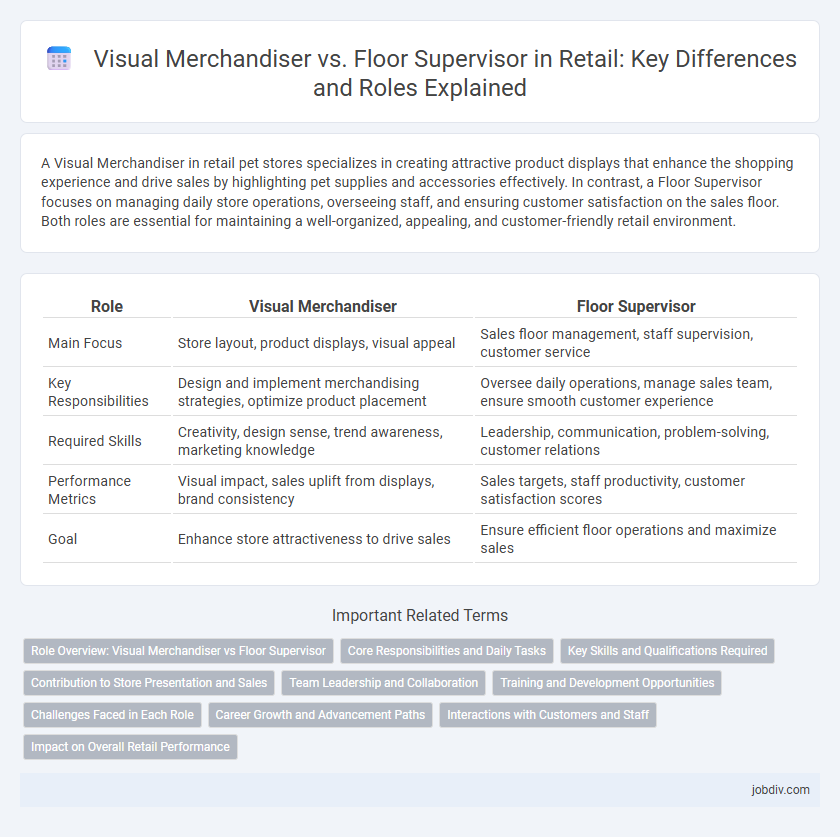A Visual Merchandiser in retail pet stores specializes in creating attractive product displays that enhance the shopping experience and drive sales by highlighting pet supplies and accessories effectively. In contrast, a Floor Supervisor focuses on managing daily store operations, overseeing staff, and ensuring customer satisfaction on the sales floor. Both roles are essential for maintaining a well-organized, appealing, and customer-friendly retail environment.
Table of Comparison
| Role | Visual Merchandiser | Floor Supervisor |
|---|---|---|
| Main Focus | Store layout, product displays, visual appeal | Sales floor management, staff supervision, customer service |
| Key Responsibilities | Design and implement merchandising strategies, optimize product placement | Oversee daily operations, manage sales team, ensure smooth customer experience |
| Required Skills | Creativity, design sense, trend awareness, marketing knowledge | Leadership, communication, problem-solving, customer relations |
| Performance Metrics | Visual impact, sales uplift from displays, brand consistency | Sales targets, staff productivity, customer satisfaction scores |
| Goal | Enhance store attractiveness to drive sales | Ensure efficient floor operations and maximize sales |
Role Overview: Visual Merchandiser vs Floor Supervisor
Visual Merchandisers specialize in creating attractive product displays and store layouts to enhance customer engagement and drive sales, utilizing design principles and market trends. Floor Supervisors manage daily store operations, ensuring staff productivity, customer service quality, and inventory control to maintain operational efficiency. Both roles are critical in retail, with Visual Merchandisers focusing on presentation and Floor Supervisors on operational management.
Core Responsibilities and Daily Tasks
Visual Merchandisers focus on designing and implementing attractive product displays to enhance customer engagement and drive sales through aesthetic appeal and strategic product placement. Floor Supervisors manage daily store operations, including staff coordination, customer service oversight, and inventory control to ensure smooth workflow and optimal store performance. Both roles require collaboration to align visual presentation with operational efficiency, maximizing overall retail productivity.
Key Skills and Qualifications Required
Visual Merchandisers excel in creativity, spatial awareness, and proficiency with design software such as Adobe Creative Suite, requiring a strong understanding of consumer psychology and brand aesthetics to create appealing product displays. Floor Supervisors need exceptional leadership skills, effective communication, and experience in sales management, with qualifications often including retail management certifications and knowledge of inventory control systems. Both roles demand adaptability, time management, and a customer-centric approach but differ in their focus on visual presentation versus operational oversight.
Contribution to Store Presentation and Sales
Visual Merchandisers enhance store presentation by designing attractive product displays that draw customer attention and drive impulse purchases, directly influencing sales performance. Floor Supervisors maintain the overall store environment, ensuring displays remain orderly and merchandise is restocked, supporting seamless customer experiences and sustained sales flow. Together, their roles dynamically contribute to maximizing visual appeal and operational efficiency, which boosts store profitability.
Team Leadership and Collaboration
Visual Merchandisers excel in creative team leadership by directing the design and layout teams to enhance store aesthetics, driving customer engagement through visually compelling displays. Floor Supervisors lead sales associates and coordinate daily operations, fostering collaboration to ensure smooth customer service and efficient workflow. Both roles require strong communication skills and the ability to motivate teams, but Visual Merchandisers focus on creative collaboration while Floor Supervisors emphasize operational management and team coordination.
Training and Development Opportunities
Visual Merchandisers undergo specialized training in design principles, brand storytelling, and seasonal display techniques to enhance customer engagement and drive sales. Floor Supervisors receive development opportunities centered on team management, customer service excellence, and operational efficiency to ensure smooth store functioning. Both roles benefit from ongoing workshops and cross-training initiatives that support career growth within retail management paths.
Challenges Faced in Each Role
Visual merchandisers face challenges such as constantly updating displays to attract consumer attention, balancing creativity with brand consistency, and managing time-sensitive promotions. Floor supervisors deal with operational hurdles including staff scheduling, resolving customer complaints efficiently, and maintaining store standards during peak hours. Both roles require strong communication skills but differ in scope, with merchandisers focused on visual appeal and supervisors on overall store functionality.
Career Growth and Advancement Paths
Visual Merchandisers specialize in creative display design, enhancing store aesthetics to boost sales, with career growth often leading to roles like Visual Merchandising Manager or Brand Experience Director. Floor Supervisors focus on overseeing daily operations, staff management, and customer service, advancing to positions such as Store Manager or Regional Manager. Both paths offer distinct advancement opportunities, with Visual Merchandisers progressing within creative and marketing domains, while Floor Supervisors climb operational management hierarchies.
Interactions with Customers and Staff
Visual Merchandisers focus on creating engaging product displays that attract customers and influence their purchasing decisions, requiring keen insights into customer preferences and behavior. Floor Supervisors manage daily store operations and lead staff, facilitating effective communication and resolving issues to ensure a smooth shopping experience. Both roles demand strong interpersonal skills, but Visual Merchandisers primarily interact through visual storytelling, while Floor Supervisors engage directly with customers and team members on the floor.
Impact on Overall Retail Performance
Visual Merchandisers influence retail performance by enhancing product presentation and creating engaging displays that attract customers and boost sales. Floor Supervisors ensure smooth store operations by managing staff, customer service, and inventory, directly affecting transaction efficiency and customer satisfaction. Effective collaboration between Visual Merchandisers and Floor Supervisors drives increased foot traffic, higher conversion rates, and improved overall retail performance.
Visual Merchandiser vs Floor Supervisor Infographic

 jobdiv.com
jobdiv.com